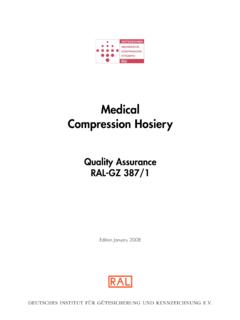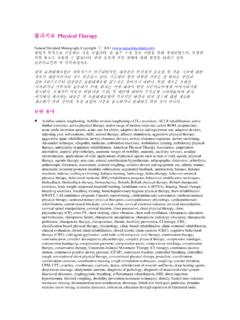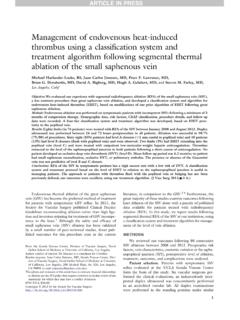Transcription of American Classification of Compression Stockings
1 American Classification of Compression Stockings TERRI MORRISON, RN, BS Graduated Compression socks and hosiery have been a proven prescription in the prevention, management and treatment of the many stages of venous insufficiency. The external graduated Compression acts as a layer of muscle by gently squeezing the stretched vein walls together, allowing the valves to close and function properly. The cavity of the vein is reduced, thereby restoring blood flow to a normal state and aiding overall circulation. American system: Graduated Compression socks or Stockings come in strengths: 8-10 mmHg,15-20mmHg, 20-30mm Hg, 25-35 mmHg for diabetics, 30-40mmHg, 40-50 mmHg and higher. They are prescribed by medical professionals and sold online, in DME ( durable medical stores), and in some medical offices and hospitals. Patients are generally taught: if they have severe symptoms, leg ulcers, or post vein procedures they may be prescribed a stronger strength than for their daily wear.
2 Many still think you mean ted socks! Sound Easy? Not Really ! Compliments of Juzo No US Government Standards for Compression Good guys do rigorous testing Quality companies test to guarantee the level of Compression stated on the box and a premium product that will fit the measurements so stated on each box. Key players follow RAL design principles and standards. SIZING Sigvaris purchased 3D renderings of 21000 legs to be sure the sizing fits TODAY S that with new technology and new yarns to provide confidence in fitting the masses. Sigvaris has a testing method compatible to the ITF method which provides curves and values for better analysis of Compression delivery. The USA FDA Standard Class II is related to the medical device, not class II Compression - this requirement is to show their effect on preventing blood pooling in the legs. The FDA classifies Compression Stockings for general medical purposes as a class I device exempt from FDA 510k pre-market notification requirements.
3 Standards rest in the hands of registered Compression stocking fitters and the physician or health care professionals who prescribe them. In the USA, there is no independent, credible lab that validates the Compression provided by Stockings . Some labs offer Compression testing, however their methods and procedures have not been validated by the Compression garment industry. Graduated Compression profiles vary from manufacturer to manufacturer. There is no reported consensus in the US on a proper Compression profile. Lack of standards has resulted in many importers and private labels with the end result of a market with a wide range of price points and Stockings with varying levels of medical efficacy. Strong Compression vs. Lightweight or Moderate? 30-40 mmHg vs. 20 mmHg High prevalence of class zero Stockings : Lower cost of garments in this Compression class Milder Compression leads to easier donning and doffing Compression therapy is a treatment modality which is several thousands years old.
4 Only during the last years, its clinical efficacy in several indications has been proved by randomized controlled trials. Hugo Partsch In a study based on the assessment of independent observers Kern et al have demonstrated that Compression Stockings in a range of 20-30 mmHg worn for three weeks are able to improve the cosmetic outcome after sclerotherapy of spider veins on the lateral thigh .. Kern But the question is: What type of Compression ? The point is obvious when you order Class 2, 30-40 mmHg MES on varying body types, sizes, young, old, skinny feet or large ankles, etc and wonder why compliance is an issue. The range of a 20-29 cm ankle in the same 30-40 mmHg prescription by the provider is going to cause a wide variation in Compression and probably cause pain in the patient with skinny feet, due to simple mechanical principles. Compression in venous leg ulcers A consensus document: Patients whose underlying CVI cannot be surgically corrected are likely to require monitored lifelong Compression to prevent ulcer recurrence.
5 This is often achieved using hosiery that gives a mild to moderate pressure of at least 18 25mmHg, and preferably up to 35mmHg if tolerated. A WORLD UNION OF WOUND HEALING SOCIETIES INITIATIVE Mild to moderate pressure? With which types of Stockings , which fabrics? What is the dynamic stiffness index? Table IV. Medical Compression Stockings versus bandages. with high stiffness Medical Compression Stockings Bandages with high stiffness "Moderate" pressure (mm Hg) 20-30 20-40 "Strong" pressure 30-45 40-60 Main indications Maintenance therapy following ulcers, DVT, postthrombotic syndrome,lymphedema - Active treatment in venous ulcers, phlebitis, DVT, lymphedema. After vein-sugery and endovenous procedures Worn Day-time Day and night Changed Every day Every several days Practicability Mobile patient can do it Trained staff needed Action during walking Working pressure is only slightly higher than resting pressure High pressure peaks during walking, strong massaging effect Main effects Edema reduction, improvement of dermal blood flow Narrowing of veins and hemodynamic effects Hundreds line up for vein care and Compression Stockings Manufacturers need support from thought leaders around the globe Boston, USA September 8-13, we can continue to repair inconsistency in Compression standards and Classification issues.
6 HOW MUCH, HOW HIGH, WHAT DSI, HOW LONG ????? Excited About Compression Guidelines, Teaching THANK YOU, ICC




